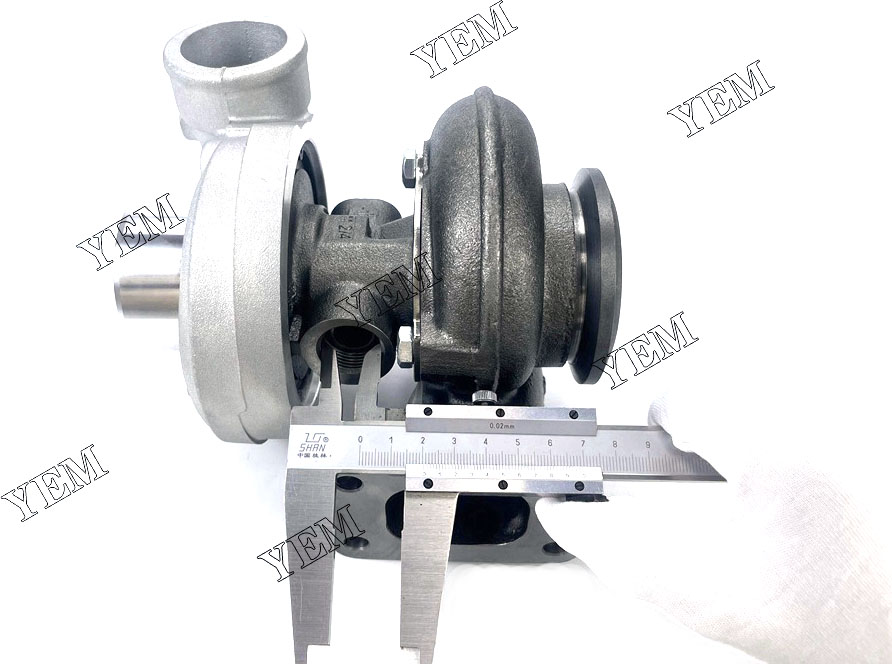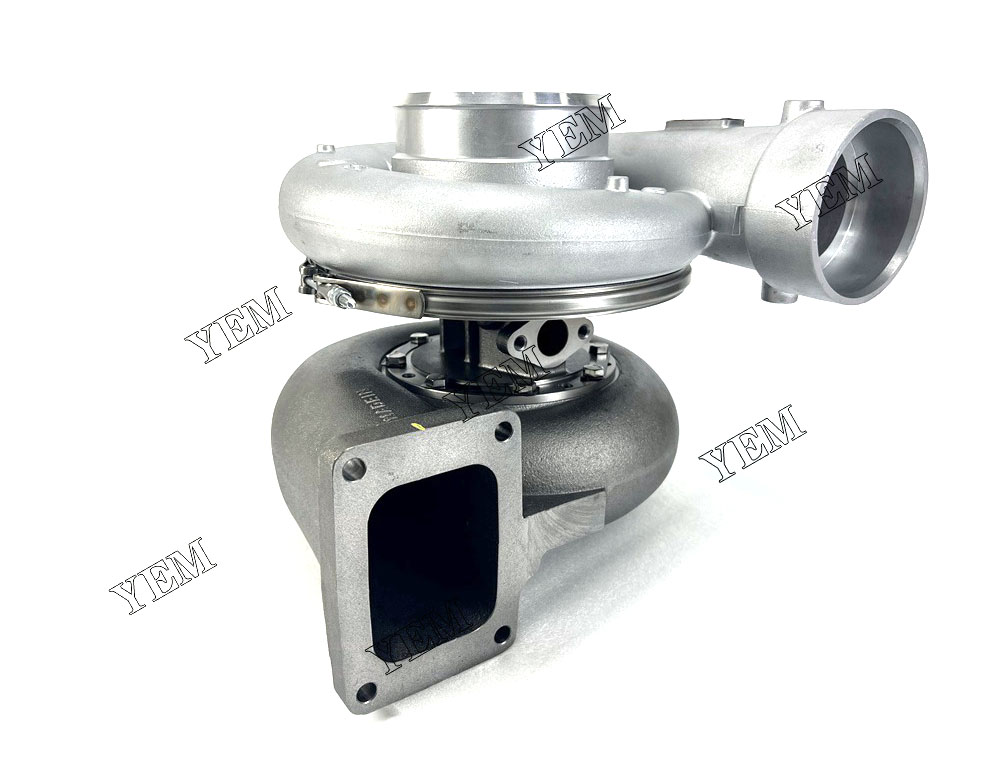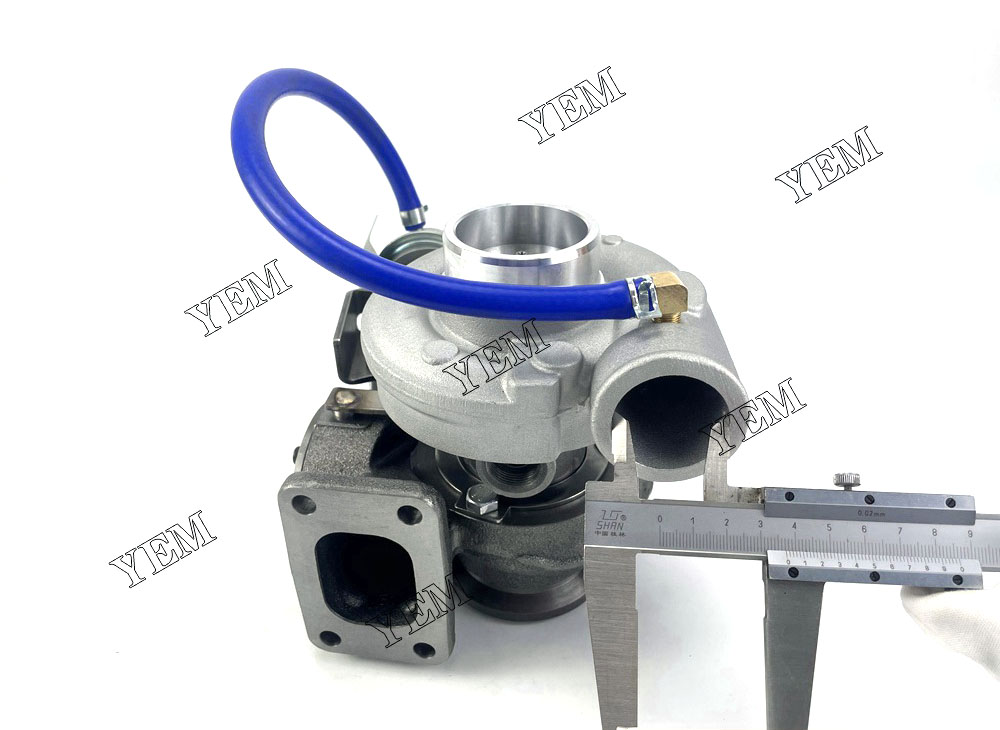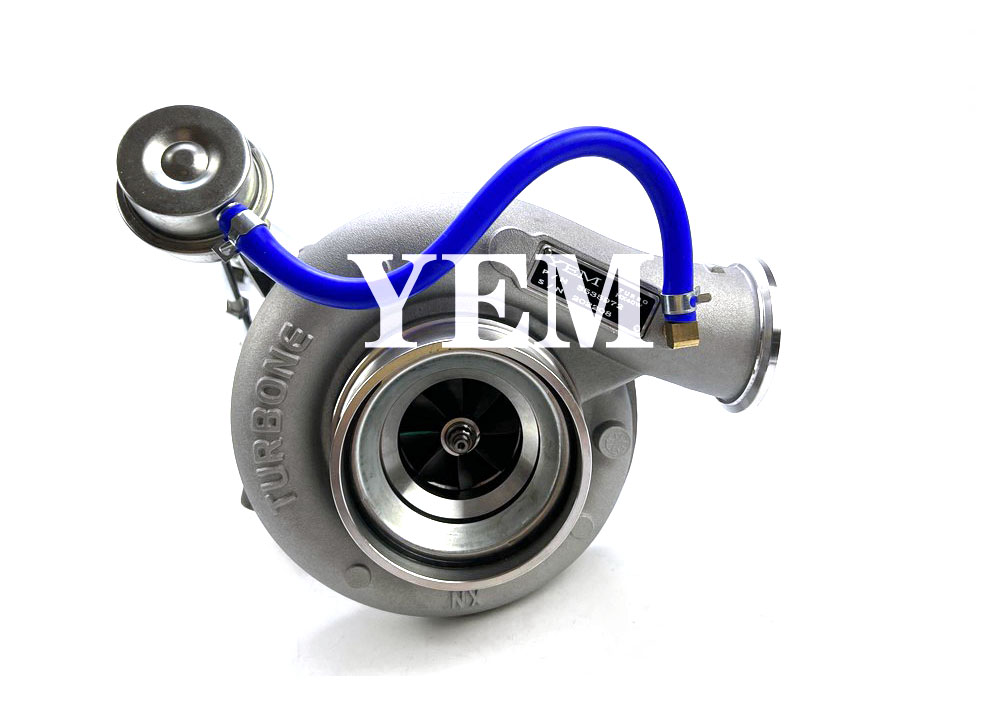How a supercharger works
The working principle of the supercharger is to use the exhaust gas energy to compress the intake air and increase the intake air density of the engine, thereby increasing the efficiency of fuel combustion and power output.
Specifically, a supercharger usually consists of two main parts: a compressor and a turbocharger.
Compressor: The compressor is located at the front end of the supercharger. It is connected to the crankshaft of the engine through the drive shaft, and uses the power of the crankshaft to compress the air. There are multiple blades inside the compressor. When the crankshaft drives the blades to rotate, the blades suck in air and compress it to form high-pressure air.
Turbocharger: The turbocharger is located at the rear end of the supercharger, and it is connected to the compressor through a shaft. Compressed, high-pressure air enters through the intake of the turbocharger and spins the turbine blades. The turbine is connected to the shaft of the compressor, so when the turbine rotates, the compressor rotates with it. The turbine is driven by the exhaust gas in the exhaust system, and the energy of the exhaust gas is transferred to the turbine, which in turn drives the compressor.
When the compressor and turbocharger work together, the supercharger compresses and sends large volumes of air into the engine’s intake tract. The increased air density after compression further improves fuel combustion efficiency and enables the engine to generate more power output. This increases engine power and torque without increasing engine displacement, improving overall performance.

Advantages and functions of superchargers
Superchargers have the following advantages and functions in vehicles and mechanical equipment:
Increased power output: The supercharger can compress more air and send it into the engine to increase fuel combustion efficiency, thereby increasing the power output of the engine. This enables a vehicle or mechanical device to produce more power and torque for the same displacement.
Improve combustion efficiency: By increasing the density of the intake air, the supercharger can improve the mixing effect of fuel in the combustion chamber, make the fuel burn more fully, and reduce the waste of fuel and the generation of emissions. This helps improve combustion efficiency and reduces exhaust emissions.
Reduced fuel consumption: Thanks to the enhanced combustion efficiency of the supercharger, the engine can use less fuel for the same power output. This helps reduce fuel consumption, operating costs and environmental impact.
Improved Altitude and Higher Temperature Performance: In areas with higher altitudes or higher temperatures, the thinner air reduces the efficiency of the engine. The supercharger can provide more oxygen to the engine by increasing the pressure of the intake air to compensate for the impact of altitude and high temperature on power output.
Improved acceleration performance: A supercharger can provide more torque at low speeds, thereby improving the acceleration performance of a vehicle or mechanical equipment. This is useful for applications that require a quick start or provide temporary extra power.
In general, a supercharger can improve the power output and combustion efficiency of the engine, reduce fuel consumption, increase performance at altitude and high temperature areas, and improve acceleration performance, etc. This makes superchargers widely used in automobiles, ships, aircrafts, construction machinery and other fields.
Supercharger Types and Selection
There are mainly the following types of superchargers:
Supercharger: The supercharger is connected to the crankshaft of the engine through mechanical devices (such as gears, chains, etc.), and uses the power of the crankshaft to compress the intake air. It has a relatively simple structure and high reliability, and is suitable for engines with low speed and high torque output.
Turbocharger: The turbocharger uses the energy of the exhaust gas to drive the rotation of the turbine blades, and then transmits the power to the compressor through the shaft to compress the intake air. It has the characteristics of high efficiency and quick response, and is suitable for engines with high speed and high power output.
Electric supercharger: The electric supercharger drives the compressor through an electric motor to compress the intake air. It offers fast response, adjustable pressure, and independence from engine speed for applications requiring flexible pressure control.

According to different application requirements and engine characteristics, the following factors need to be considered in selecting a suitable supercharger:
Power requirements: According to the power requirements of the engine, select a supercharger that can provide sufficient pressure and flow. Turbochargers are generally good for high power outputs, while superchargers are good for low power outputs.
Speed range: The turbocharger responds quickly to the speed and is suitable for the high speed range, while the supercharger has lower requirements for the speed and is suitable for the low speed range.
Pressure adjustment: If the pressure needs to be adjusted according to different working conditions and loads, the electric booster can provide more flexible pressure adjustment capabilities.
Energy saving and environmental protection: turbochargers have advantages in improving combustion efficiency and energy saving, and can reduce fuel consumption and emissions.
Reliability and maintenance cost: The structure of the supercharger is relatively simple, with high reliability and low maintenance cost.
When selecting a supercharger, the above factors need to be considered comprehensively, and the selection should be made according to specific application requirements and engine characteristics. In addition, factors such as the brand reputation, quality and after-sales service of the supercharger should also be considered.
Supercharger care and maintenance
The maintenance and maintenance of the supercharger is very important for its normal operation and extended service life. The following are some common supercharger maintenance and maintenance considerations:
Replace the supercharger oil seal regularly: There is an oil seal inside the supercharger to keep the oil-air separation between the turbine and the compressor. Regular inspection and replacement of the turbocharger oil seal can prevent the turbine from being oiled and damaged.
Clean the turbine wheel: Oil and carbon deposits can build up on the turbine wheel, preventing it from functioning properly. Cleaning the turbine impeller regularly to keep its surface smooth and clean will help improve the efficiency of the supercharger.
Check the supercharger for oil leakage: Regularly check the supercharger for oil leakage, especially the connection between the turbine and the compressor. If oil leakage is found, the seals should be repaired or replaced in time to prevent oil from entering the turbine and compressor and causing damage.
Keeping the Turbo Running: The rotor components of a turbocharger need to keep spinning properly for the supercharger to work properly. Regularly check the status of the turbine bearings and rotors to ensure adequate supply of lubricating oil, and replace worn bearings and parts in time.
Check the intake and exhaust ducts of the supercharger: Make sure the intake and exhaust ducts of the supercharger are unobstructed to avoid obstruction of airflow and loss of pressure.
Regularly check the working pressure of the supercharger: through the pressure gauge of the supercharger or other monitoring devices, regularly check whether the working pressure of the supercharger is normal. If there is any abnormality, adjust or repair the supercharger in time.
Pay attention to the working temperature of the supercharger: the supercharger will generate high temperature during operation, pay attention to the heat dissipation and ventilation around the supercharger to avoid damage caused by overheating.
Follow the manufacturer’s maintenance recommendations: Different brands and models of superchargers may have different maintenance requirements. It is recommended to follow the manufacturer’s maintenance manual and recommendations for regular maintenance and maintenance.

It should be noted that the maintenance and maintenance of superchargers generally need to be carried out by professional technicians to ensure correct and safe operation. Regular maintenance and maintenance can prolong the service life of the supercharger and improve its performance and reliability.
Supercharger troubleshooting
Here are some common troubleshooting methods when a supercharger fails:
Abnormal sound: If the supercharger has abnormal noise or sound, it may be due to damage to the turbine impeller, bearing wear or collision. It is recommended to check the condition of the turbine wheel and bearings and replace damaged parts if necessary.
Oil leakage: If you find that the supercharger has oil leakage, it may be due to aging or damage to the seals. Check the booster seals and replace to make sure they are properly sealed.
Unstable pressure: If the operating pressure of the supercharger is unstable, it may be caused by a blocked intake pipe, a failure of the pressure regulator, or damage to the internal components of the supercharger. It is recommended to check whether the intake pipe is unblocked, repair or replace the pressure regulator, and check the state of the internal parts of the supercharger.
Power drop: If the power output of the engine drops significantly, it may be caused by a decrease in the efficiency of the supercharger or damage to the internal components of the supercharger. It is recommended to check the turbine impeller for carbon deposits and damage, clean or replace the turbine impeller, and check whether other parts of the supercharger are normal.
Overheating: If the supercharger is overheating, it may be due to a malfunctioning cooling system, insufficient lubricating oil, or damage to internal parts of the supercharger. Check the working status of the cooling system to ensure that the coolant supply is normal; check the amount and quality of lubricating oil, and add or replace lubricating oil in time; check the status of internal parts of the supercharger, and repair or replace if necessary.
Note that troubleshooting of the supercharger may require a professional technician to ensure proper and safe operation. If you do not have relevant technical knowledge and experience, it is recommended to leave the troubleshooting work to professional maintenance personnel.
Development trends of superchargers
A supercharger is a device that can increase the density of the intake air of the engine by compressing the intake air, thereby increasing the power output of the engine. With the continuous development of the automobile industry and engine technology, the supercharger is also constantly perfected and improved. The following are some trends in supercharger development:
- Higher efficiency: With the increasing awareness of energy conservation and environmental protection, people have higher and higher requirements for engine efficiency. The design and manufacture of superchargers are developing towards higher efficiency to improve the combustion efficiency and energy utilization of the engine.
- Smaller size and lighter weight: With the trend of lightweight vehicles, the supercharger also needs to reduce the size and weight as much as possible to reduce the weight of the vehicle and improve fuel economy and driving performance.
- Multi-stage supercharging technology: Traditional superchargers usually only have single-stage supercharging, while multi-stage supercharging technology can further increase the engine compression ratio and intake air density. Multi-stage superchargers can avoid excessively high intake air temperatures and overexpanded airflow problems through interstage cooling and intake air drying.
- Electric supercharger technology: The electric supercharger uses electric power to drive the supercharger impeller to rotate, which can control the supercharger pressure more precisely and provide faster response speed. Electric supercharging technology can also be combined with new energy vehicle technologies such as hybrid and electric vehicles to provide more efficient power output.
- Variable valve technology: superchargers are usually designed with variable flow passages or variable flow passage geometry to adapt to the intake requirements under different working conditions. The variable valve technology can realize more precise air intake control and improve the dynamic response capability and combustion efficiency of the engine.
Generally speaking, the development trend of superchargers is more efficient, lighter and more intelligent. With the continuous progress and technological breakthroughs in the automotive industry, superchargers will continue to evolve to provide engines with more optimized power output and lower emission levels.
Market applications of superchargers
Superchargers are widely used in the market. The following are some common market applications for superchargers:
Automotive field: Superchargers are widely used in gasoline and diesel engines in the automotive field. By increasing the density of the intake air, a supercharger can increase the power output and torque performance of the engine. Many high-performance cars and racing vehicles use superchargers to increase power performance. In addition, superchargers are also an important part of modern small-displacement engines. High power and good fuel economy of small-displacement engines can be achieved through supercharging technology.
Construction machinery field: superchargers are also widely used in construction machinery, such as excavators, loaders and bulldozers. These high-power construction machinery usually require high torque output, and the supercharger can provide additional intake pressure to improve the output capacity of the engine.
Aviation field: Superchargers are also used in the aviation field. Aircraft power systems often employ turbochargers to improve engine performance when the aircraft is flying at high altitudes. A supercharger counteracts the thin air at high altitudes, ensuring the engine gets enough oxygen.
Energy field: Superchargers are also used in energy equipment such as gas turbines and steam turbines. The supercharger can increase the intake pressure of the combustion system, improve the combustion efficiency of fuel, and increase the energy output of the equipment.

It should be noted that with the rise of new energy vehicles, such as pure electric vehicles and fuel cell vehicles, the application of superchargers in these vehicles may decrease. That’s because these vehicles don’t need fuel to burn to provide power, so rely less on superchargers.
Contact us
YEM Professional Excavator Parts Team is a dedicated and experienced team specializing in providing high-quality parts for excavators. With our extensive knowledge and expertise in this field, we offer a comprehensive range of parts to meet the diverse needs of our customers.
Whether you require replacement parts for hydraulic systems, engine components, chassis components, or any other excavator component, the YEM team has got you covered. We source our products from reputable manufacturers and ensure that each part meets the highest standards of quality and durability.
What sets us apart is our commitment to exceptional customer service. We understand the importance of timely support and strive to promptly respond to inquiries and requests. Our knowledgeable staff is readily available to help customers identify the correct parts for their specific excavator model and provide installation and maintenance instructions.
To contact the YEM Specialized Excavator Parts team, you can reach us through our website, email, or phone. We are dedicated to building long-term relationships with our customers and are eager to assist you with all your excavator parts needs.
